They say Kyoto’s the most visited place on earth, outside Mecca. Jishu Shrine stands within the Kiyomizu complex, which is the city’s no. 1 tourist spot and a magnet for bus tours. To say it gets crowded is an understatement. It’s why I haven’t really dared visit, but summoning up my courage this week I took the plunge and carefully choosing an offseason week day with bad weather, I made my way up the Kiyomizu slope. It was packed!
Founded in 778, Kiyomizu has been famous since its foundation for the veranda platform offering spectacular views over the city nestling in the valley below. It was rebuilt in 1633, and when you think of the traffic it caters to, it’s an amazing achievement. Astonishingly, not a single nail was used in the construction.
Jishu Shrine gets a Green Shinto thumbs up for its outreach to foreigners. Not only does it provide English-language explanations, but it has a leaflet which proclaims inclusivity: ‘There is only one human race even though there are many nationalities.’ The picture of the chief priest carries the caption, ‘International Rotary Club Member’ and the shrine’s good luck charms are clearly identified in English: a love charm will set you back Y500 but that for a good marriage will cost Y1000. On the other hand, the promise of a good delivery is a bargain at Y500.
Jishu Shrine is small but packed with features. It’s probably the best place I know of to get a concentrated understanding of Japan’s love affair with enmusubi (match-making). Here’s a ten-step trip through the shrine.
1) Okuninushi
Once you’ve passed through the temple, you come to the shrine buried deep within the complex. It’s one of the most famed match-making shrines in the country, dedicated to the ‘god of love’, Okuninushi. Anyone looking for romance or marriage is sure to head here, and not surprisingly it’s full of young girls.
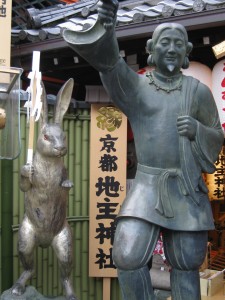
Okuninushi and the hare of Inaba
Okuninushi (literally, master of the country) is known as a land-builder, since he helped develop the Izumo kingdom. However, he was forced to cede the land to the Yamato sometime around the beginning of the fifth century. I’ve often heard it said that he’s associated with enmusubi because he subsequently married a Yamato princess and thereby cemented harmony between the kingdoms, tying the knot as it were in a big way (could that be why Izumo Shrine has the biggest shimenawa knot in Japan?).
From an eminent archaeologist at my university, however, I got a different version. In the accord reached between Yamato and Izumo, he noted, the former took worldly power while the latter was given charge of spiritual matters. It explains why even to this day all of Japan’s kami meet up in Izumo once a year in November. As host of the annual gathering, Okuninushi is the one who brings them together and sets up meetings. By extension, he became the kami of connections in love matters too. He not only initiates meetings, but helps ensure harmony.
2) How about the hare?
This is the year of the hare (or rabbit): how appropriate then that Okuninushi’s familiar should be a hare. It’s an auspicious time to visit, but how did the association come about?
It’s all to do with the legend of the Hare of Inaba. As punishment for deception, it had been skinned alive and was trying to seek help. Okuninushi took pity on it and suggested a cure. It turned out the hare was in reality a figure of importance, and in return for Okuninushi’s help the hare became his devoted ally and advised him how to get the princess he was seeking.
3) Love rocks!
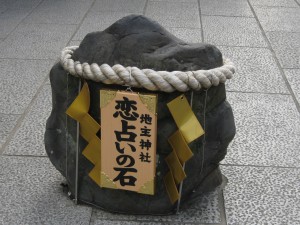
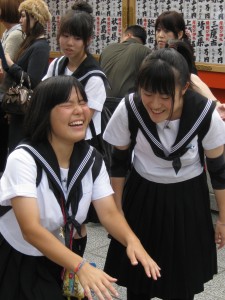
Love is blind, but if you believe hard enough you can still stumble upon it
The centrepieces of the shrine, almost literally, are two love rocks. They stand six meters apart. According to the shrine, if you can walk between the two stones with your eyes shut, then you are going to be lucky in love. Should someone help you, by shouting directions for instance, then you will find love but only through the help of another. The challenge is popular with schoolgirls, who thread their way through the other visitors with eyes shut and arms outstretched.
4) What’s with all the Daikoku?
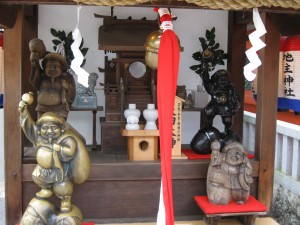
Daikoku corner
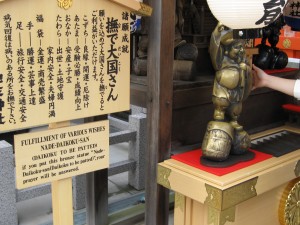
Give Daikoku a pat to make your prayers come true
Move around the shrine and you keep seeing jolly Daikoku, one of the Seven Lucky Gods and associated with Buddhism. He originated in India as Shiva, and entered Japan from China where he evolved into a deity of wealth. (He was featured on the country’s first bank note.) He carries a treasure sack on his back, holds aloft a ‘wealth-pounding’ wooden mallet, and stands upon rice bales.
Now here’s a funny thing. The Chinese characters for Okuni can also be read as Daikoku. It means the two deities became conflated in the popular imagination, cementing the Shinto-Buddhist syncretism. It’s handy for worshippers, since in one go you can get love as well as wealth.
5) Hitogata
Placed at the sides of the shrine are a couple of tables with hitogata paper figures designed to wash away your problems. These little cut-outs are similar to the sympathetic magic of medieval witchcraft, whereby dolls were used to represent others for healing purposes. In this case you write your problem on the paper, place it in the water and it will all be washed away. Not bad for Y200!
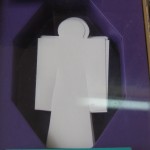
Hitogata
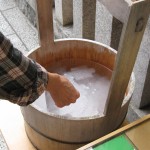
Washing away the problem
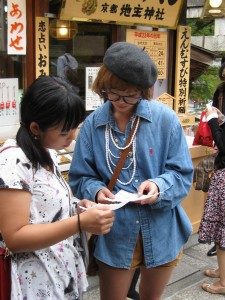
Comparing fortunes
6) Omikuji (fortune slips)
Divination was an important part of ancient Shinto, and the practice is carried on today in the popular fortune slips of Shinto shrines. Here the focus is on love and what’s in store romantically. All over the shrine people are paused in contemplation of what’s in store for them. Those with good luck might fold them up and keep them in their purse or pocket as a treasured item. Those who are not so lucky will tie them up on the strings provided in the hope the kami will take care of it and free them for something better.
7) Ema (prayer plaques)
Ema prayer tablets sell at a brisk pace, and are hung up around the shrine. They depict Okuninushi and his hare on one side; on the other are earnest requests for a love-match or marriage. Some are simple enough, though others take a more creative or personal approach.
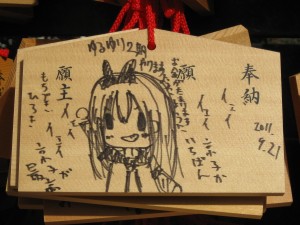
Someone with a crush on a particular young girl on the other
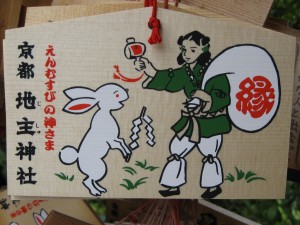
Okuninushi and the hare of Inaba on one side of the ema
8) Noticeboards of thanks
Watch out for the noticeboards with letters of thanks to the shrine from those who have found love or marriage following their visit. These are obviously good propaganda for the shrine and are proudly displayed. Some of them even come from abroad.
9) Witch’s curse
Okage myojin was a kami believed to grant prayers, particularly for femaies, and in the shrine are cedars associated with the deity. They were used for ‘Ushinotoki mairi’ (visits at the time of the cow i.e. the dead of night at 2 a.m.). It’s said that women would nail a straw doll on the cedar in order to put a curse on their enemies, and marks of the nails are still evident on the cedars. The practice reminded me of trees in a graveyard in Oxford I once saw, which also bore the legacy of nails hammered into them on which prayers had been pinned. In both cases the tree acted as an animistic conduit to the spirit world.
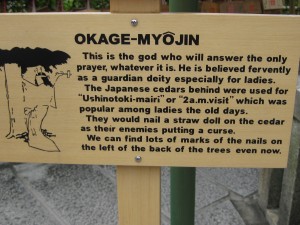
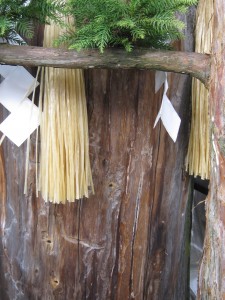
Nail holes are still evident on the sacred tree
10) Water-splash Jizo (Mizukake Jizo)
Jizo is the Buddhist guardian of travellers and the underworld. What’s he doing in a Shinto shrine? It’s a legacy of the Shinto-Buddhist fusion that for over a thousand years characterised this site. Though the Meiji government artificially separated the two religions in the late 1860s, they remain inextricably bound up still.
Here’s something not many people know, since it’s widely assumed that Jishu Shrine is part of Kiyomizu. In fact since Meiji times it’s operated as a completely independent institution. The fee one pays at the entrance to the complex is only to enter the temple. The shrine is free. If you walk in the back way to Kiyomizu (where everyone exits), you can simply walk up to Jishu Shrine without paying. However, you won’t be able to enter the temple with its viewing platform because there’s a guard at the entrance.
Kiyomizu has been a popular place of pilgrimage since the ninth century. If you dare to join the throngs and visit Jishu Shrine, you’ll find a small space that packs a punch in terms of interest. It’s sure to make for a fascinating visit. Who knows: you may just find love or marital harmony too!

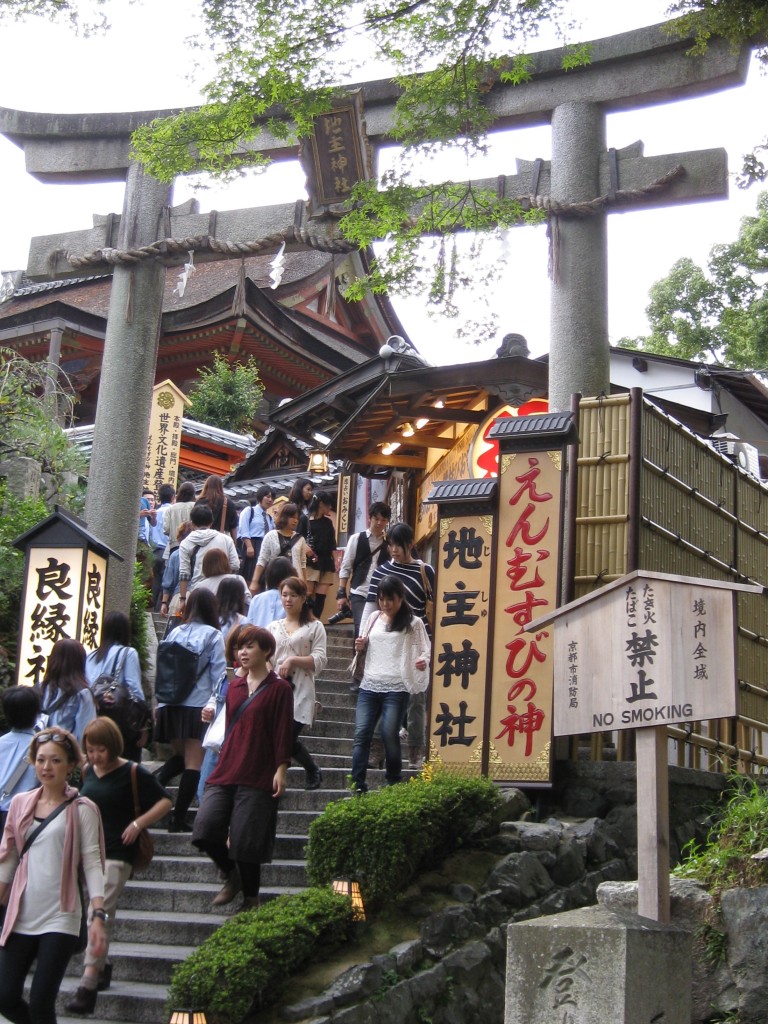
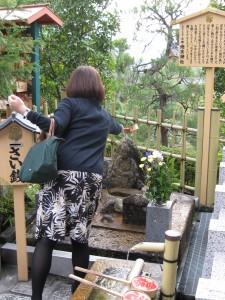
The shrine seems to close off the same time or even earlier than the temple which is not like other shrines that doesn’t block it’s main entrance in the evening and I wonder if anyone should walk through the “Do not enter” signS along the way :-P I wish they’d state on the sign that Jishu Shrine through the back.
How might I find a sincere Japanese girl –
Interested in long term relationship, marriage
and children – preferably aged between 25 and 35 –
I am a retired Lawyer with my own business and company.
I am single and based in Dublin – Ireland.
Good day, Vincent. There are reputable dating agencies, such as http://meetjapanlady.com/ If however you’re asking in spiritual Shinto terms, then I suggest that you come over to Japan and visit as many ‘enmusubi’ shrines as you can. The top one is generally acknowledged to be Izumo Shrine. Apart from being able to make prayers for a love relationship, blessed and endorsed by a kami, you will find the enmusubi shrines are full of young women eager to find a partner. Who knows, you might even find your perfect match while waiting in the queue to pray…